Top>HAKUMON Chuo [2013 Autumn Issue]>Chuo University High Schools place top 2
 Index
Index
High school comedy championships
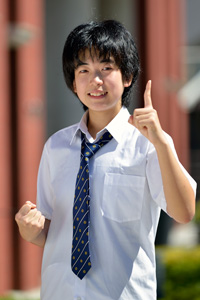
Chuo University High Schools place top 2
The 3rd Smile Koshien (sponsored by Niihama City, Ehime Prefecture) was held on August 24th and 25th in Niihama City, Ehime Prefecture. At the competition, high-school students from performance clubs such as manzai (Japanese standup comedy), rakugo (Japanese comedic storytelling) and conte (short comedic skits) competed to see who is the funniest in all of Japan. Manzai comic Karina Hanazawa, a 3rd-year student at Chuo University Senior High School, won the Grand Prize from among 44 groups from throughout Japan. The Runner-Up Prize was won by rakugo comic Yoshiki Mimura, a 3rd-year student at Chuo University Suginami High School. The contest has been held by Niihama City since 2011 in an effort to make comedy a part of community building.
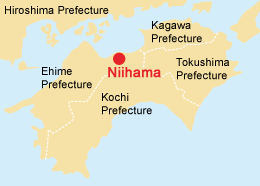
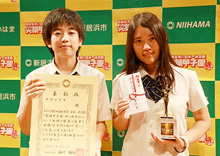
Hanazawa (left) and Shimada smile on the awards platform (photograph provided by Hanazawa and Shimada)
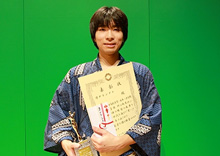
Yoshiki Mimura, winner of the Runner-Up Prize (photograph taken from contest homepage)
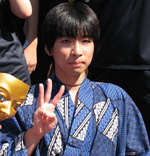
Scene from a sports festival
Panda Calendar
Hanazawa, a 3rd-year student at Chuo University Senior High School, formed the manzai comedy duo Panda Calendar with Haruka Shimada (3rd-year student at the Upper school of Koen Girls School), her classmate from kindergarten to junior high school.
Hanazawa’s appearance on the championship stage was met by stares from the audience. With her short hair, white dress shirt, necktie and black pants—could she be a boy?! “Sorry that my partner’s gender is unknown,” Shimada apologized while Hanazawa smiled.
The duo’s theme was thinking about the future, a suitable topic for high school students. “My dream? I hope I can receive my pension,” dreamed Hanazawa, only to be met with a sharp rebuke from Shimada—“You haven’t even paid into the fund yet!”
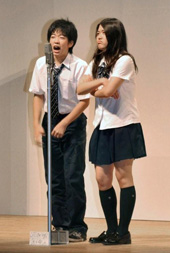
Scene from performance
“I have a dream that I hope comes true. If only I could play the piano…if only I could become Momotaro-zamurai,” said Hanazawa, appealing to older audience members by referencing a nostalgic song and historical drama. The duo also entertained children by including Niihama City’s mascot Niihama-Machuri in their performance. It was a painstaking effort by the two comedians to satisfy the contest’s requirement of appealing to all age groups.
The duo engaged in comedic dialogue with perfect timing. The foolish pauses by Hanazawa emphasized the humor and spread further laughter throughout the audience. Panda Calendar passed the first day of the contest in 1st place. The next day, the duo displayed outstanding tempo at the finals en route to winning the Grand Prize for high school comedy in Japan.
When the name Panda Calendar was announced as the Grand Prize winner, Shimada expressed her joy by spreading her arms wide apart. The pose was reminiscent of the famous scene from the film Titanic. Hanazawa quickly played the role of Dicaprio, supporting Shimada from behind and continuing to joke even in her moment of joy.
“Last year, I competed by myself and didn’t even come close to winning a prize,” said Shimada emotionally. “I’m so happy that we were able to compete together this year and win the Grand Prize.” In contrast, Hanazawa was cool and collected. “I enjoyed performing manzai during the past two days. It was also fun to meet the mascot Niihama-Machuri which was part of our routine. Niihama City, thank you very much!”
Later, when asked about her calm demeanor, Hanazawa gave the following explanation. “I tried to keep a balance with Shimada’s reaction. It would have been strange for us both to cry.” No matter the situation, Hanazawa fulfills her role in the duo Panda Calendar.
A duo since their 3rd year of junior high school
Hanazawa and Shimada started performing manzai together from their 3rd year of junior high school. They appeared in small local comedy performances. Hanazawa enjoyed watching comedy shows on television and also watched DVDs featuring full versions of manzai performances. She became interested in creating her own routines and writing scripts.
Hanazawa created scripts packed with gags. Her jokes were designed to get the audience laughing in stages, similar to a 2-stage or 3-stage rocket.
The next step for Hanazawa was to begin performing. Sometimes, she was disappointed when the audience did not laugh at her jokes. Other times, she was surprised to receive unexpected laughter at certain parts of her performance. Overall, it was a learning experience for Hanazawa, who always strived to entertain those in front of her.
The winner of the 1st Smile Koshien was a close acquaintance of Hanazawa’s. She submitted a DVD of her comedy routines for preliminary judging of the contest. “I was shocked to have been selected to participate in the contest. The first thing I thought was that I needed to tell my parents,” said Hanazawa, who had not talked much about her performances. “My folks were really surprised when I told them I was going to Niihama City.”
Although Hanazawa had wanted to compete as a manzai duo in last year’s contest, the contest schedule conflicted with performance club activities and Shimada ended up competing solo.
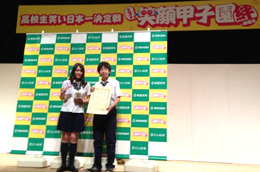
At this year’s contest, the duo fulfilled their dream of performing together. Even so, they had trouble arranging their routine since they both live and go to school far away from each other. Hanazawa rode an overnight bus and arrived in Niihama City at 6am on the morning of the contest. She was met at the bus stop by Shimada, who had stayed in Niihama the previous night. The pair was taken to the beach by a city hall worker. Hanazawa and Shimada practiced their routine while gazing at morning scenery on the Seto Inland Sea. They worked frantically until they entered the contest venue at 11am.
Good things kept happening after the duo won the Grand Prize. “My parents had been looking at the contest website and congratulated me when coming home,” said Hanazawa.
Even during summer vacation, Hanazawa had practice in the performance club and went back to school on the day following the contest. “I planned on announcing our victory at practice, but everyone already knew. I was so happy when everyone congratulated me.”
On Twitter, Hanazawa saw that the Like button had been pressed by an elementary school classmate who she had not seen for a long time.
Her smile and the smile of the audience are inextricably linked. In the future, Hanazawa wants to create even more laughter.
Hanazawa’s goal as a comedian is to become as popular as the duo Bakusho Mondai.
Duo Name
The name Panda Calendar contains two n sounds. In Japan, it is said that comedic duos with n sounds in their name will become popular. Some examples include Downtown, Ucchan Nanchan, Bakusho Mondai and Ninety-Nine. Hanazawa and Shimada were sure to include an n sound in their own name.
Smile Koshien
Competitors are selected based on a DVD video sent to the contest office for preliminary judging. About 10 groups are selected to compete in the contest. The first day of the contest features competition between similar age groups in two performances: 1) kindergarten to university students, and 2) housewives, working adults and senior citizens. The following day, competition is held for an overall winner. All competitors are applicable for the Grand Prize. Competitors perform 3 routines over the 2-day period. The contest requires routines to be amusing for all age groups. Grand Prize winners from the past 2 contests have become professional comedians.
-
Outstanding predecessors
Many popular rakugo performers have graduated from Chuo University Senior High School such as rakugo master Yanagiya Kosan and master Yanagiya Kodanji (age 68). Kodanji is also a proficient swordsman with the rank of 7-dan in kendo and Kosan was selected as human national treasure. Master Yanagiya Sankyo (65) was awarded the Art Encouragement Prize (Public Art Division) from the Ministry of Education in March of this year. Master Kokontei Shinsuke (60) has appeared on the NHK children’s program Okaasan to Issho for the past 17 years. All of them are great masters.
Rakugo performers from Chuo University
In addition to the previously mentioned master Yanagiya Kodanji (Faculty of Economics), other current rakugo performers include master Sanyutei Ryuraku (Faculty of Law), master Hayashiya Sampei (Faculty of Economics), Shumputei Choya (Faculty of Letters) and Hayashiya Tsuruko (Faculty of Letters).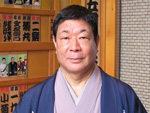
Master Yanagiya Sankyo
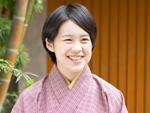
Hayashiya Tsuruko
A newcomer with great potential
Yoshiki Mimura / 3rd-year student at Chuo University Suginami High School
The Runner-Up Prize was won by Yoshiki Mimura, a 3rd-year student at Chuo University Suginami High School and member of the Rakugo Society. His stage name is Sanyutei Chosuke and uses kanji杉from the Japanese name for Suginami High School. This was the second consecutive year that a student from Suginami High School has won the Runner-Up Prize. Last year, the prize went to a performer named Sanyutei Tsukinosuke.
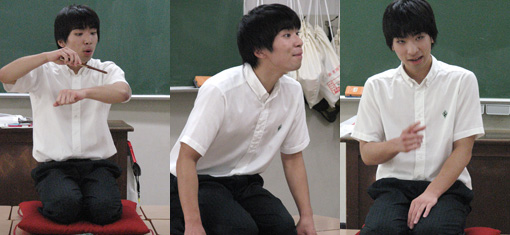
A national tournament like Smile Koshien should be enough to make anyone nervous—but that was not the case for Mimura. “I was able to keep my composure while performing,” he says. “I went on stage thinking that I belonged there and was able to perform even better than usual.”
Mimura gave a bold and confident performance of the rakugo story Gojo-Kyu. During the performance, he pretended to light a large bundle of mugwort on fire and held an obstinate expression as he endured the heat. The height of his performance was gestures which indicated his enduring of the heat.
Mimura’s series of expressions and actions impressed the audience. While holding the imaginary flaming mugwort, he rolled up his left sleeve to expose his upper arm. He wore an expression of endurance, tore out his hair in agony from the heat, and cast a heartrending gaze upon the flames.
In the championship, Mimura acted upon the advice of those around him and hurriedly incorporated a local joke into his performance. “People from Niihama could endure the heat, but I wonder about people from Imabari…” he said at the beginning of his performance, referencing the rivalry between the two cities. Audience members raised their voices in excitement.
Mimura’s confidence grew. “I thought that I might receive the Judges Special Prize or the Shikoku Prefectural Prize,” he says when discussing his expectations before the awards announcement. However, the names of other performers were called for these awards. “At that point, I had almost given up on receiving a prize,” he recalls. The only awards remaining were the Grand Prize and Runner-Up Prize. Mimura wondered if he might be selected…only to have his name called suddenly!
He had been selected for the Runner-Up Prize. His face stiffened and he held his right hand against his left chest—perhaps to check his rapidly beating heart or perhaps to enjoy his excitement. When the results for total score combining the first day and championship round were announced, Mimura learned that he had posted the top score of the 11 performance held in the championship round. He finally broke into a smile. He had drastically improved upon his 8th-place standing after the first day.
Mimura first encountered rakugo when he was recruited to join the Rakugo Society after entering high school. The Rakugo Society at Chuo University Suginami High School advertised itself to prospective members in an unusual fashion, with club advisor and teacher Akinori Kikuchi performing a short rakugo story. Mimura recalled how he had read about a foreigner’s encounter with rakugo in an English textbook at junior high school.
“I wanted to do something different from everyone else,” he says. Four new students joined the Rakugo Society. The kanji for flower, bird, wind and moon were used in the respective stage names of the new members. A girl club member was named Ohana (flower).
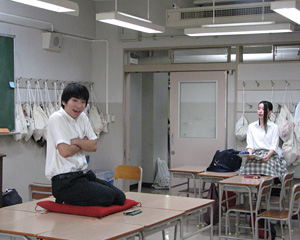
Practicing rakugo in the classroom. From left, Mimura and Ohki. Maeda is off-camera to the right.
Practice is held twice per week after school. Classroom desks are pushed together to form a stage. Mimura sits upon a futon and claps his hands to signal the start of practice of each member.
1st-year student Nozomi Maeda performs the story Tsuru, which portrays transformation from kubinaga-dori (ancient Japanese name for crane) to tsuru (current name for crane). Nozomi’s powerful voice rings clearly throughout the classroom.
Keika Ohki, a 1st-year female student, practiced an auspicious rakugo, Jugemu. Keika portrays the tenderness of a mother as she pretends to rock her sleeping baby Jugemu. Both Nozomi and Keika applied to compete in the national comedy contest.
Mimura practices rakugo everyday. He sits on desks in the classroom, tells stories at home and talks in the bathtub. He even memorizes his routines while riding on the train.
Mimura is a big fan of rakugo master Yanagiya Sankyo, an alumnus of Chuo University Senior High School. Mimura also collects rakugo DVDs and CDs. He studies speaking techniques while watching the videos. “I must not speak too quickly,” he constantly reminds himself. When portraying the craftsman Hattsan and the retired master, he turns his face to differentiate between the two characters. When portraying a child, he clasps his hands together and holds them out in front. When acting as a woman, he places his hand on his chest.
He waits patiently and silently when making the difficult pauses which add flavor to the performance. “It’s difficult to wait,” Mimura says. “It takes courage.” Even when seeing or hearing the same story, he makes new discoveries every time. Rakugo is undeniably enjoyable for him. Mimura was invited to tell a rakugo story at a gathering of senior citizens. He felt a sense of accomplishment when the audience enjoyed his storytelling.
At the national contest, the emcee praised his performance of Gojo-Kyu as soon as it was finished. The audience agreed with the emcee’s praise. “He used pauses skillfully when telling his story,” praised judge Katsura Sanko, a disciple of Katsura Bunshi (previously known as Sanshi). “He has a powerful aura when taking the stage—unheard of for a high school student. I sense limitless potential in him.”
Mimura plans to enter Chuo University next spring. “I was unsure about continuing rakugo while studying at university,” he says. “But after receiving the Runner-Up Prize, I’ve made up my mind—I want to join the rakugo club at university!”
Chuo University is happy to welcome a newcomer with limitless potential.
-
What?! We’re both part of Chuo!?
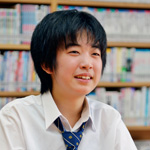
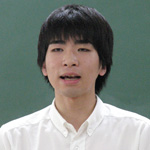
Hanazawa and Mimura met at a party on the night before the championship round. During self-introductions, all competitors said the name of their high school. After Hanazawa announced that she attends Chuo University Senior High School and Mimura revealed that he attends Chuo University Suginami High School, the two performers greeted each other with smiles and expressed their surprise. “Let’s meet again at Chuo University,” they promised. Their deepened friendship will continue into the future.
- Research Activities as a Member of Research Fellowship for Young Scientists (DC1), Japan Society for the Promotion of Science (JSPS) Shuma Tsurumi
- Important Factors for Innovation in Payment Services Nobuhiko Sugiura
- Beyond the Concepts of Fellow Citizens and Foreigners— To Achieve SDGs Goal 10 “Reduce Inequality Within and Among Countries” Rika Lee
- Diary of Struggles in Cambodia Fumie Fukuoka
- How Can We Measure Learning Ability?
—Analysis of a Competency Self-Assessment Questionnaire— Yu Saito / Yoko Neha - The Making of the Movie Kirakira Megane








